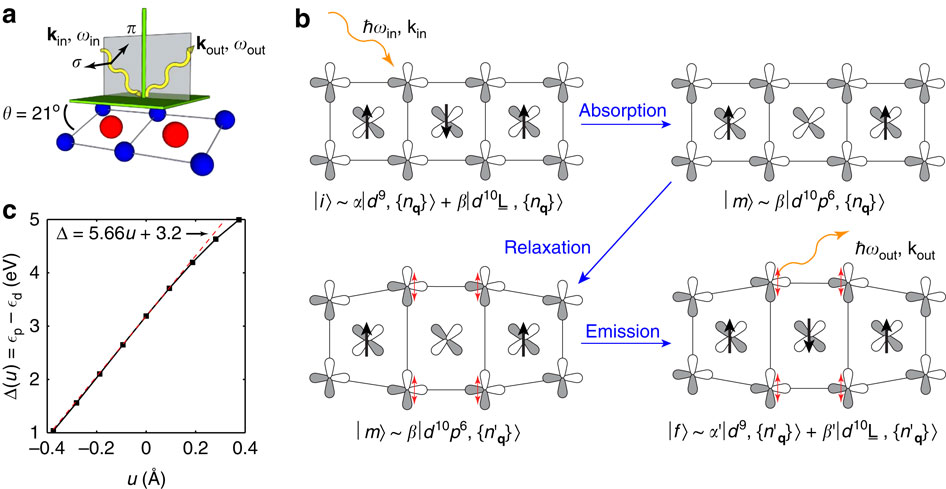当前位置:
X-MOL 学术
›
Nat. Commun.
›
论文详情
Our official English website, www.x-mol.net, welcomes your
feedback! (Note: you will need to create a separate account there.)
Electron-lattice interactions strongly renormalize the charge-transfer energy in the spin-chain cuprate Li2CuO2.
Nature Communications ( IF 14.7 ) Pub Date : 2016-Feb-17 , DOI: 10.1038/ncomms10563 Steve Johnston , Claude Monney , Valentina Bisogni , Ke-Jin Zhou , Roberto Kraus , Günter Behr , Vladimir N. Strocov , Jiři Málek , Stefan-Ludwig Drechsler , Jochen Geck , Thorsten Schmitt , Jeroen van den Brink
Nature Communications ( IF 14.7 ) Pub Date : 2016-Feb-17 , DOI: 10.1038/ncomms10563 Steve Johnston , Claude Monney , Valentina Bisogni , Ke-Jin Zhou , Roberto Kraus , Günter Behr , Vladimir N. Strocov , Jiři Málek , Stefan-Ludwig Drechsler , Jochen Geck , Thorsten Schmitt , Jeroen van den Brink

|
Strongly correlated insulators are broadly divided into two classes: Mott-Hubbard insulators, where the insulating gap is driven by the Coulomb repulsion U on the transition-metal cation, and charge-transfer insulators, where the gap is driven by the charge-transfer energy Δ between the cation and the ligand anions. The relative magnitudes of U and Δ determine which class a material belongs to, and subsequently the nature of its low-energy excitations. These energy scales are typically understood through the local chemistry of the active ions. Here we show that the situation is more complex in the low-dimensional charge-transfer insulator Li2CuO2, where Δ has a large non-electronic component. Combining resonant inelastic X-ray scattering with detailed modelling, we determine how the elementary lattice, charge, spin and orbital excitations are entangled in this material. This results in a large lattice-driven renormalization of Δ, which significantly reshapes the fundamental electronic properties of Li2CuO2.
中文翻译:

电子-晶格相互作用强烈地使自旋链铜酸盐Li2CuO2中的电荷转移能重新正常化。
高度相关的绝缘子大致分为两类:Mott-Hubbard绝缘子(其中绝缘间隙由过渡金属阳离子上的库仑斥力U驱动)和电荷转移绝缘子(其中间隙由电荷转移能量驱动)阳离子和配体阴离子之间的Δ。U和Δ的相对大小决定了材料属于哪一类,进而决定了其低能激发的性质。这些能级通常是通过活性离子的局部化学来理解的。在这里,我们表明,在低维电荷转移绝缘子Li2CuO2中,情况更为复杂,其中Δ具有较大的非电子成分。结合共振非弹性X射线散射与详细建模,我们可以确定基本晶格,电荷,自旋和轨道激发纠缠在这种材料中。这导致Δ的大晶格驱动重归一化,从而显着重塑了Li2CuO2的基本电子性能。
更新日期:2016-02-20
中文翻译:

电子-晶格相互作用强烈地使自旋链铜酸盐Li2CuO2中的电荷转移能重新正常化。
高度相关的绝缘子大致分为两类:Mott-Hubbard绝缘子(其中绝缘间隙由过渡金属阳离子上的库仑斥力U驱动)和电荷转移绝缘子(其中间隙由电荷转移能量驱动)阳离子和配体阴离子之间的Δ。U和Δ的相对大小决定了材料属于哪一类,进而决定了其低能激发的性质。这些能级通常是通过活性离子的局部化学来理解的。在这里,我们表明,在低维电荷转移绝缘子Li2CuO2中,情况更为复杂,其中Δ具有较大的非电子成分。结合共振非弹性X射线散射与详细建模,我们可以确定基本晶格,电荷,自旋和轨道激发纠缠在这种材料中。这导致Δ的大晶格驱动重归一化,从而显着重塑了Li2CuO2的基本电子性能。





















































 京公网安备 11010802027423号
京公网安备 11010802027423号